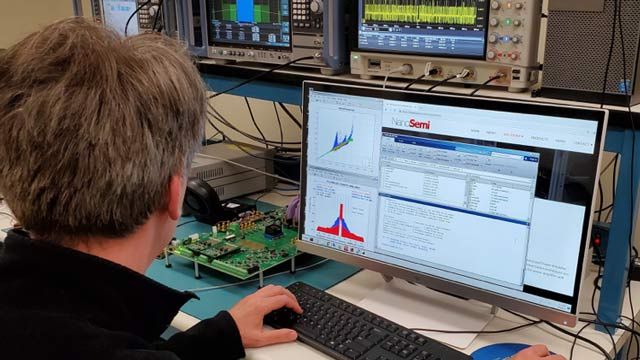NanoSemi Improves System Efficiency for 5G and Other RF Products
“At a small company like ours, it’s critical for engineers to work with as little overhead as possible. With MATLAB, our team can deliver leading-edge IP faster, enabling our customers to increase bandwidth, push modulation rates higher, and reduce power consumption.”
Challenge
Accelerate the design and verification of RF power amplifier linearization algorithms used in 5G and Wi-Fi 6 devices
Solution
Use MATLAB to characterize amplifier performance, develop predistortion and machine learning algorithms, and automate standard-compliant test procedures
Results
- Development time reduced by 50%
- Iterative verification process accelerated
- Early customer validation enabled

NanoSemi linearization IP development and verification using MATLAB.
Wireless standards such as 5G and 802.11ax (Wi-Fi 6) support data rates up to 20 times higher than 4G and other previous standards. To meet these speed and bandwidth requirements, hardware manufacturers need optimal performance from RF power amplifiers (PAs).
Engineers at NanoSemi have developed digital predistortion (DPD) that linearizes RF power amplifiers. This approach enables the PAs to operate at peak power while minimizing distortions and other undesirable effects that impair signal quality. Developed with MATLAB®, this technology improves the performance of the RF signals and enables higher throughput and reduced power consumption for 5G and Wi-Fi 6 devices as well as infrastructure equipment.
“MATLAB has become essential to what we do every day,” says Kevin Chuang, lead engineer at NanoSemi. “We use MATLAB to characterize RF hardware, automate testing, create custom IP, and improve communication with our customers. Doing all this in the same environment that we use for advanced algorithm development significantly reduces our time-to-market.”
Challenge
To help their customers operate PAs more efficiently in next-generation devices, NanoSemi engineers wanted to develop algorithms that would compensate for nonlinear behavior by applying adaptive DPD, predictive machine learning models, and other proprietary techniques. The engineers needed to develop, debug, optimize, and implement these algorithms rapidly; iterate with customers to ensure that systems under development met their needs; and conduct thorough regression testing across a wide range of operating conditions.
Solution
NanoSemi engineers use MATLAB to accelerate the development and validation of algorithms that improve wireless transmit system linearity and overall performance.
They import measurement data from spectrum analyzers or commercially available software-defined radios into MATLAB using Instrument Control Toolbox™. After analyzing and visualizing the measured data, they use it to fit parameters of a behavioral PA model developed in MATLAB.
Next, the engineers develop and tune DPD and machine learning algorithms for linearizing amplifier output. These algorithms incorporate signal smoothing, digital filtering and time-frequency analysis tools available in Signal Processing Toolbox™.
The engineers test the algorithms using standards-compliant waveforms—including E-UTRA test model (E-TM) waveforms—that they generate with LTE Toolbox™ .
They use MATLAB Compiler™ to encrypt and package their linearization IP as a standalone executable that their customers can run to evaluate its performance.
After incorporating customer feedback and enhancement requests, the NanoSemi digital design team implements the algorithms on an FPGA, ASIC, or SoC.
Once deployed to hardware, the implementation is verified using automated testing scripts developed with MATLAB and Instrument Control Toolbox. These scripts control and communicate with the target hardware and send text-based SCPI commands via Virtual Instrument Software Architecture (VISA) standard protocols to signal generators, signal analyzers, and other test equipment.
The team uses the scripts to automate regression tests and conduct parameter sweeps. Results from the test equipment are analyzed in MATLAB and stored in a database.
NanoSemi has used this workflow to deliver commercial-grade IP blocks for semiconductors used in 5G and LTE mobile devices, as well as base stations and Wi-Fi products.
Results
- Development time reduced by 50%. “Depending on the difficulty of the project and scope of work, we typically complete development in a few months,” says Chuang. “Without MATLAB we would almost certainly need twice as much time—and that’s a conservative estimate.”
- Iterative verification process accelerated. “MATLAB enables us to generate, acquire, and analyze data from simulations and over-the-air tests at the same time, a capability that other test environments do not have,” Chuang says. “This greatly speeds up iterations with our customers.”
- Early customer validation enabled. “With MATLAB Compiler we can send our customer a fixed-point implementation of a specific module,” says Chuang. “It’s a clean exchange of information. While our IP is protected, the customer can see how it performs, which is a significant advantage because it minimizes errors due to misunderstanding.”